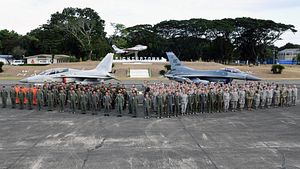From January 21 to February 1, 2019, the U.S. Pacific Air Forces together with the Philippine Air Force conducted the seventh iteration of the Bilateral Air Contingent Exchange-Philippines (BACE-P) at the Cesar Basa Air Base in Pampanga. Established in 2016, the BACE-P is a regular two-week joint exercise that seeks to facilitate the exchange of operational and technical expertise, improve interoperability, and enhance the air power capabilities of both countries. The seventh BACE-P featured an interfly training between the U.S. F-16 and Philippine FA-50 fighter aircraft as well as subject matter expert exchanges on an array of topics including intelligence, communications, flightline, and maintenance backshop operations. Previous iterations of the BACE-P had been held at the Clark and Mactan Air Bases and had included assets such as A-10C Thunderbolt II close air support aircrafts, C-130 Hercules transport aircrafts, HH-60 G Pave Hawks Helicopters, and E/A 18G Growler electronic warfare aircrafts.
The seventh BACE-P was conducted amid uncertainties surrounding the U.S.-Philippines alliance. Externally, the operational environment of the alliance is becoming more volatile. Geopolitical tension between the United States and China continues to rise in light of Beijing’s steady militarization of the South China Sea (SCS). In a near-collision incident last October for instance, China’s Lanzhou guided-missile destroyer maneuvered unprofessionally towards the USS Decatur while it was conducting a freedom of navigation operation near Gaven Reef, a Chinese-occupied artificial island in the SCS. As an added layer of complexity, under Philippine President Rodrigo Duterte, America’s oldest ally in Asia continues to seek improved political and economic relations with China while shelving the favorable arbitral ruling on the South China Sea dispute. Should an operational miscalculation involving U.S. and Chinese vessels occur in the SCS, it would definitely place Manila in a diplomatic dilemma between supporting Washington as a treaty ally or invoking neutrality in consideration of its comprehensive strategic cooperation with Beijing.
Internally, questions regarding the U.S. commitment to defend the Philippines have resurfaced. Last December, Philippine Defense Secretary Delfin Lorenzana announced Manila’s intention to review the Mutual Defense Treaty (MDT) of 1951 in order to clarify the U.S. position on certain provisions regarding Washington’s commitments in the event of an armed attack in Philippine-claimed and -occupied features in the SCS. Giving a fair assessment of Manila’s intention, Lorenzana shared that the intended purpose of the MDT review is to make the alliance stronger. However, in another occasion the secretary also hinted that the treaty may possibly be scrapped based on the outcome of the said review.
Considering these uncertainties, the successful conduct of joint exercises such as the BACE-P demonstrates the resilience of the U.S.-Philippines alliance as well as the robust institutional ties that bring the allies together. The continuity of military exercises between the two countries displays a shared intention to keep the alliance intact and relevant. In this regard, notwithstanding uncertainties concerning the future of the U.S.-China rivalry in the SCS and the possible outcome of an MDT review, the value and contribution of exercises such as BACE-P to the respective defense priorities of the allies should not be dismissed.
For the United States, bilateral exercises across the region such as the BACE-P contribute in ensuring that the U.S. commitment to a free and open Indo-Pacific is felt and recognized by partners and competitors alike. As China’s geopolitical influence and strategic foothold in the region continues to expand, it behooves Washington to maintain close military relations with countries such as the Philippines to reinforce the U.S.-led system of alliances and security partnerships and preserve a rules-based regional order. It is from this logic that the U.S. Defense Strategy seeks to strengthen alliances and attract new partners through mutual respect, collaboration, and interoperability. In providing an avenue for regular interactions between soldiers, sailors, and airmen, exercises such as BACE-P satisfies this defense priority.
For the Philippines, such exercises are consistent with the government’s strategy of enhancing its alliance and strategic partnerships and modernizing the deterrent and self-defense capabilities of its ground, naval, littoral, and air forces. In particular, the Philippine Air Force, which aspires to develop a credible air defense posture by 2028, benefits from such exercises in three ways: 1) enhancing interoperability with its U.S. counterpart, 2) promoting the professional and technical mastery of its personnel on air power, and 3) drawing lessons for new doctrines and training programs on air force joint war-fighting functions.
In conclusion, while there are external and internal constraints to the U.S.-Philippines Alliance, both countries should strive to maintain robust military-to-military ties in view of the mutual and strategic benefits it provides.
Christian Vicedo is a security analyst based in Manila. His writings have appeared in the Pacific Forum, East Asia Forum, and The Diplomat.

































